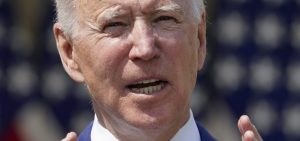News
Biden Proposes $1.5 Trillion Federal Spending Plan
By: Brian Naylor | Barbara Sprunt | NPR
Posted on:
WASHINGTON, D.C. (NPR) — The Biden administration Friday unveiled a $1.5 trillion partial budget request for the next fiscal year, calling for increases across a range of domestic programs aimed at fighting poverty and climate change, while keeping defense spending relatively flat.

The administration’s first budget blueprint does not contain details of the president’s $2 trillion infrastructure and jobs plan, nor does it lay out projected spending on programs such as Social Security and Medicare. Details on those and the president’s proposed tax increases are promised later this spring.
The budget numbers released Friday would increase overall spending on discretionary programs by $118 billion, or 8.4% above last year’s levels. Defense spending would remain essentially flat, with an increase of $12.3 billion, or 1.7%, while other domestic programs get a 15.9% boost.
While the budget figures are just an outline of the administration’s priorities for the upcoming fiscal year, they nonetheless represent what is expected to be a return to higher levels of domestic spending under Biden. That’s because for the first time in a decade, Congress and the White House won’t be constrained by the across-the-board spending caps put in place in 2011 in order to reduce the federal deficit. Those caps expire at the end of the current fiscal year on Sept. 30.
A senior administration official told reporters that the president believes “now is the time to begin reversing this trend and reinvesting in the foundations of our country’s strength.”
One of the biggest beneficiaries under the president’s proposal is spending on education, which would see an increase of nearly $30 billion, or 40.8%. Much of that would go to high-poverty schools, aiming to reduce funding disparities with wealthier schools.
The Centers For Disease Control and Prevention would receive $8.7 billion, which the administration says is the biggest increase in two decades, and would “restore capacity at the world’s preeminent public health agency.
Other items include:
- Climate change investments spread across almost every agency, representing a $14 billion increase over 2021. This would include $1.4 billion for environmental justice initiatives, the largest direct investment in history, according to the Office of Management and Budget
- A new Advanced Research Projects Agency for Health would get $6.5 billion to focus on diseases such as cancer, diabetes and Alzheimer’s
- Opioids research, prevention and treatment would get $10.7 billion, an increase of $3.9 billion
- Gun violence initiatives at the Justice Department would get $2.1 billion, an increase of $232 million
- Aid for Central American countries aimed at curbing migration would see an initial investment of $861 million
- Foreign aid programs — a common target for cuts during the Trump administration — would see a boost, including $1 billion for global health security programs, $2.5 billion for international climate programs and more than $10 billion in humanitarian aid for refugees and conflict victims abroad
- Amtrak, a favorite mode of transportation for the president, would receive $2.7 billion, a 35% increase, with much of that targeted for improving and expanding the heavily traveled Northeast corridor
- The IRS, which Democrats say was chronically underfunded in recent years, would receive a $1.12 billion, a 10.4% increase
The partial budget was delayed in part because the administration lacks a confirmed budget director, after nominee Neera Tanden withdrew because of opposition from several key senators who cited what they said were offensive tweets. The Office of Management and Budget is being lead by Shalanda Young, the deputy OMB director.
Administration officials also cited a lack of cooperation from the outgoing administration of former President Donald Trump as a reason it took the Biden team several weeks longer than anticipated to draft their spending plan.
The budget announcement comes after Biden last week unveiled a proposal worth about $2 trillion to overhaul the country’s infrastructure, a plan that includes billions in new spending to repair bridges, highways and roads, expand access to high-speed broadband and upgrade schools.
The hope among Democrats is that carving out infrastructure spending as a separate venture could open a path to winning Republican votes in Congress, where Democrats have a thin majority. President Biden has said he is open to negotiations with Republicans, but the White House has also signaled it is prepared to move forward without GOP support.
So far, the president’s plans have run up against stiff resistance from GOP lawmakers. Not a single Republican voted for the administration’s $1.9 trillion coronavirus relief package, and support for the infrastructure plan has so far failed to materialize.
9(MDI4ODU1ODA1MDE0ODA3MTMyMDY2MTJiNQ000))

